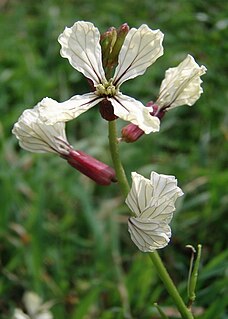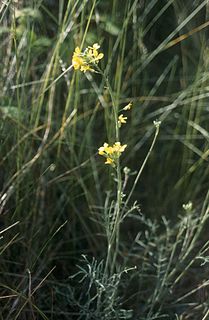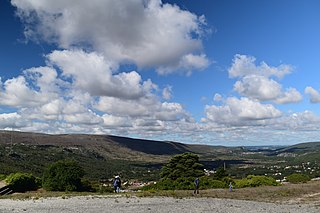
Tibouchina Aubl. is a neotropical flowering plant genus in Melastomataceae Juss. that contains approximately 240 species. Species of this genus are herbs, shrubs or trees and typically have purple flowers. They are native to Mexico, the Caribbean, and South America where they are found as far south as northern Argentina. Members of this genus are known as glory bushes, glory trees or princess flowers. The name Tibouchina is adapted from a Guianan indigenous name for a member of this genus [2]. A recent systematic study has shown that this genus is paraphyletic.

Dactylis is a genus of Eurasian and North African plants in the bluegrass subfamily within the grass family. They are known in English as cock's-foot or cocksfoot grasses, also sometimes as orchard grasses.

Joannesia is a genus of plants in the family Euphorbiaceae, first described as a genus in 1798. The entire genus is endemic to Brazil.

Raphanus raphanistrum, the sea radish, wild radish, white charlock or jointed charlock, is a flowering plant in the family Brassicaceae. One of its subspecies, Raphanus raphanistrum subsp. sativus, includes a diverse variety of cultivated radishes. The species is native to western Asia, Europe and parts of Northern Africa. It has been introduced into most parts of the world and is regarded as a habitat threatening invasive species in many areas, for example, Australia. It spreads rapidly and is often found growing on roadsides or in other places where the ground has been disturbed.

Dipteryx is a genus containing a number of species of large trees and possibly shrubs. It belongs to the "papilionoid" subfamily – Faboideae – of the legume family (Fabaceae). This genus is native to South and Central America and the Caribbean. Formerly, the related genus Taralea was included in Dipteryx.
The Habitats Directive is a directive adopted by the European Community in 1992 as a response to the Berne Convention. The European Community was reformed as the European Union the following year, but the directive is still recognised.

Coincya is a genus of flowering plant that belongs to the family Brassicaceae. Three species of the plant are endemic to the British Isles., these being Coincya wrightii, Coincya cheiranthos (nokkasinapit) and Coincya monensis, which has two subspecies, C. monensis subsp. monensis and C. monensis subsp. recurvata.

Coincya monensis subsp. monensis, the Isle of Man cabbage, is a species of plant in the family Brassicaceae that is found in coastal habitats on the west of the island of Great Britain and around the coasts of the Isle of Man.

Eruca is a genus of flowering plants in the family Brassicaceae, native to the Mediterranean region, which includes the leaf vegetable known as arugula or rocket.

Serras de Aire e Candeeiros Natural Park (PNSAC) is a natural park in Portugal. It is one of the 30 areas which are officially under protection in the country. It is the most important repository of limestone formations in Portugal.

Serra de Montejunto Protected Landscape is a protected landscape in the Montejunto-Estrela mountain range, spanning the municipalities of Alenquer and Cadaval in Lisbon District, Portugal. It is the highest natural viewpoint of Estremadura, rising to 666 metres (2,185 ft) of altitude. The area is part of the Estremenho Limestone Massif. Geologically is 15 kilometres (9.3 mi) long and 7 kilometres (4.3 mi) wide, and is rich in caves, sewage ponds and prehistoric fossils.

Oplismenus is a small genus of annual or perennial grasses, commonly known as basketgrass, found throughout the tropics, subtropics, and in some cases, temperate regions of the Americas, Africa, Asia, and Australia. The systematics of the genus are unclear, with over 100 described species, only 7 species are officially recognized as of 2016.
Chaetobromus is a genus of African plants in the grass family.

Coincya monensis is a plant species in the family Brassicaceae. Coincya monensis is native to western Europe and Morocco, but has been introduced in North America.

Allium pallens is a species of wild onion native to the Mediterranean region and Middle East from Portugal and Algeria to Iran.
Arabis sadina is a species of flowering plant in the family Brassicaceae. It is endemic to Portugal.

Iris subbiflora is a plant species in the genus Iris, it is also in the subgenus Iris. It is a rhizomatous perennial, from Portugal and Spain in Europe. It has evergreen broad leaves, forming dense clumps, it has dwarf stems in late spring,, with 1 upright fragrant flower, in shades of purple, light red purple, grey-blue, blue-violet, or dark violet. It has a beard which is generally blue, purple, or violet, but can fade to white, dull yellow, or dark yellow. After being found in 1804, it was once a separate species until the late 70s, when it was reclassified as subspecies of Iris lutescens, and renamed Iris lutescens subsp. subbiflora. But in the 80s it was returned to an independent species but some authors and references still class the species as a synonym or subspecies. It is cultivated as an ornamental plant in temperate regions.
Micromeria forbesii is a species of flowering plants of the genus Micromeria. The species is endemic to Cape Verde. It is listed as endangered by the IUCN. It was first described by George Bentham in 1834. Its local name is erva-cidreira, or cidreirinha. In traditional medicine, it is used as an infusion for the treatment of indigestion, diarrhea, cough and to stimulate labour.

Periploca laevigata is a species of flowering plant in the family Apocynaceae, native to the Canary Islands, the Savage Islands and Cape Verde.

Digitalis mariana is a flowering plant species in the family Plantaginaceae. It is a perennial foxglove with evergreen foliage and rose-red coloured flowers produced in summer. It is native to Portugal and Spain.















